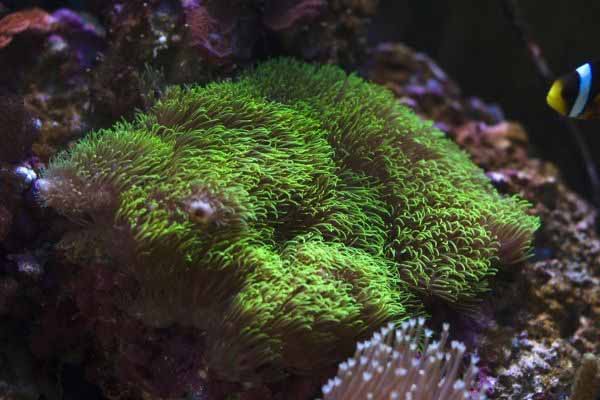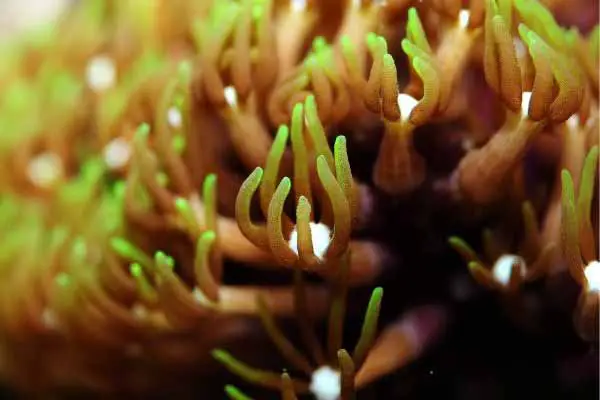The Green Star Polyp (GSP) is an excellent beginner soft coral and may work best as an ideal first coral choice because they’re: hardy, fast-growing and can be kept in a variety of locations in your tank.
Sound intriguing? Then let’s dive deeper into what it takes to care for green star polyps in your home aquarium!
Table of Contents
- Quick Facts
- Taxonomy, Morphology, and Body Structure
- Ideal Conditions for Green Star Polyps
- GSP Placement in Saltwater Aquariums
- Lighting Requirements
- Feeding and Nutritional Requirements
- Troubleshooting: Green Star Polyps Closed or Not Opening in the Tank
- How to Frag Green Star Polyps
- Compatibility in a Tank with Green Star Polyps
- Special Considerations for GSP Aquarium Care
- For More Information
Quick Facts
- Scientific Name: Pachyclavularia violacea
- Common Names: Green star polyps or GSPs
- Care Level: Easy
- Aggression Level: Peaceful, but it will try to grow over everything in reach
- Color: Green polyps, white center, purple mat or stolon
- Coral Group: Soft corals
- Growth Form: Encrusting
- Key Nutrients: Nothing special
- Temperature: 78-82F (25.5-27.8 C). Mine survived a several day power failure with temperatures in the 50F-range
- pH: 8.2
- Alkalinity: 8-12dkH
- Calcium: 400ppm
- Salinity (measured as specific gravity): 1.025
- Ammonia, Nitrates, and Nitrites: 0ppm

Taxonomy, Morphology, and Body Structure
The scientific name for green star polyps (GSP) is Pachyclavularia violacea. Other names are starburst polyps, star polyps, and daisy polyps. According to Borneman, in Aquarium Corals, green star polyps were one time thought to be Clavularia viridis, but this turned out to be a misidentification. They are octocorallians. This means they belong to the Class (subclass, actually) of corals with eight tentacles on every polyp.
They are also part of the Alcyonacea Order, which means they are part of the same part of the coral family tree as leather corals. Each tentacle has a serrated appearance when examined close-up, as you can see in the image below.

(Sorry the image quality is so grainy. I took these photos in my tank without special magnification gear – just the physical and digital zoom. But it provides some context to the relative size of the serrations)
Each of the coral polyps gets attached to each other at the colony base by a thick, rubbery purple matt called a stolon.
Natural Range for Green Star Polyps
GSPs are native to the rubble areas of reefs and lagoons and are often found with Xenia and Clavularia. They commonly stick to areas with nutrient-rich waters and a low water flow (Borneman 2001).
Are Green Star Polyps Poisonous?
GSPs aren’t poisonous in the same way that zoanthid polyps are. Some palythoa zoanthid species have a toxic chemical called Palytoxin that they release when stressed.
Hopefully, this goes without saying, but your GSPs are NOT for human consumption, regardless of what I just wrote regarding palytoxin! Finally, just because they don’t have palytoxin doesn’t mean they won’t damage neighboring corals as they grow. They will. (Hope that helps)

Ideal Conditions for Green Star Polyps
Standard aquarium water parameters are perfect for these corals. Keep your water temperature stable – around 78F. Use a high-quality reef salt mix, like Instant Ocean, and maintain a specific gravity of around 1.025. Top off the tank with moderate-to-strong LED lights and at least low-to-moderate water flow. After a few months, you’ll have to trim your green star polyps back to keep them from growing over everything.
It is worth mentioning that the ideal conditions listed above work for most soft coral species. No special care is particularly required to keep these corals beyond the typical husbandry skills required for any coral species.
GSP Placement in Saltwater Aquariums
GSP corals are not fussy and will thrive wherever you put them – as long as you meet the minimum conditions required (i.e., adequate light, water flow, and water quality).
However, the best placement for green star polyps in a reef tank is in an area with moderate flow and lighting. As shown in these images, colonies like to spread out along the back and side walls of the aquarium glass. They will tend to expand and retract over time. But the area directly in the flow and under the lights thrive the most.
I’m convinced the main reason for this cyclical growth pattern is related to the amount of light. If I increased the light around the periphery of my tank, the growth might continue to greater amounts.

Lighting Requirements
You may hear the term “bulletproof coral” to describe the hardiest corals available in the hobby. It is certainly a curious phrase. And, of course, it’s an exaggeration. But lighting requirements are fairly straightforward for this hardy, beginner soft coral:
- Avoid extremes (high- and low-intensity)
- Acclimate the coral to your tank if you DO have powerful LED lights
- Don’t move the coral around to different parts of your tank (changing light and water flow conditions)

The polyps appear the most aesthetically pleasing with blue or actinic lighting. You’ll help make the green polyps pop. But it’s not required to grow in your tank.
Feeding and Nutritional Requirements
GSP corals are partially photosynthetic and get nutrition from their symbiotic zooxanthellae. They also presumably absorb nutrients from the water column, as well, and have historically done well in systems with well-fed fish. Their polyps will also capture and pull in food particles that they catch in the water column. While target-feeding will likely increase growth rates, this coral grows quite well under normal reef aquarium conditions without supplemental feeding.
If you are new to the hobby, or if your green star polyp colony is one of the first in a new tank, you may want to consider target feeding to accelerate the growth and help fill in some empty substrates with living corals. But please keep in mind, this is already a naturally fast-growing coral, which may colonize more surface area than you had already planned.

Do You Need to Feed Green Star Polyps?
Yes, you should feed your GSP. All corals are animals. This sometimes gets forgotten since we focus so much on having the right amount of light. But it’s generally best to feed your corals.
Troubleshooting: Green Star Polyps Closed or Not Opening in the Tank
When disturbed, polyps can fully retract into the stolon for protection. This tends to happen:
- In response to cutting, fragging, or trimming back the coral
- At night
- When stressed (say, during power failures)
- When salinity is off (For instance, when I haven’t topped off the tank with fresh water in TOO LONG)
I’ve observed that GSP corals exhibit a shared response depending on the severity of the disruption. Minor disturbances tend to cause only a few polyps – those closest to the disturbance – to retract. But if I scrape away stolon and polyps covering up slits in the overflow (a more dramatic disturbance), polyps across the entire colony retract.
The coral looks like this, with polyps retracted:

How to Frag Green Star Polyps
These are one of the easiest corals to frag. They’re an encrusting coral type that grows on almost any substrate. If you line up a few pieces of live rock rubble touching the surface of the green star polyps, the polyps will grow out from the base rock and encrust the new surface. Then you can free up the frags by cutting the stolon with a knife or scissors.
If you want to learn how to frag green star polyps or any other coral, download my definitive guide.
Compatibility in a Tank With Green Star Polyps
Unlike some coral species, green star polyps don’t have stinging tentacles, called nematocysts. So they are relatively peaceful and compatible with other coral species. GSPs grow quickly and encrust on anything within reach, including other corals.
So if you want to keep green star polyps with other coral species, you need to maintain physical separation between the rocks the GSPs are growing on and neighboring rocks, or the green star polyps will eventually take over EVERYTHING.
Special Considerations for GSP Aquarium Care
Green star polyps are a fantastic beginner coral because they grow fast and adapt well to life inside a home aquarium. Because they will grow on just about any substrate, they are a great coral to get creative with in your tank. GSPs will grow up aquarium glass or the overflow. They can encrust wires or tubes, allowing you to turn any surface inside your aquarium into a fuzzy, living mat.
My green star polyps have grown up the tank’s back wall in my display tank (technically an overflow). Where can you grow them?

GSPs will grow on any aquarium surface, including glass, plastic, live rock, and even other corals. I have witnessed all three behaviors in my own tanks. The image below was taken in my display tank a few years ago. Notice the coral growing up the back wall (where the overflow is located) and out the sidewall.

Each year in my tank, the GSPs seem to go through a series of growth and recession cycles. My tank is a 92-gallon bowfront aquarium. There is a central, massive GSP colony covering most of the back wall of the aquarium and the live rock. And the coral grows outward, on the sides in both directions. The polyps attempt to grow forward over every surface, including rocks, other corals, and aquarium glass!
Check out this short video all about green star polyps!
For More Information
Green star polyps are a popular coral species for reef tank owners. Check out out a few of these other great coral species:
- Toadstool coral
- Hammer coral care
- Mushroom corals
- Kenya tree corals
- Acan corals
- Favia corals
- Gonipora
To learn more about caring for green star polyps in your reef tank, you can watch this handy YouTube video:
Where to Find Green Star Polyps For Sale
GSP corals are an aquarium staple and available at most local and online stores. Considering how well they grow and easy they are to frag, I’m always a bit surprised by the price tag. Especially since anyone growing this soft coral would likely give away a frag for just a few dollars. But I know operating a local fish store is a tough business. I suspect these popular corals help keep the lights on for most people.
Written by Albert B. Ulrich III, Author of The Reef Aquarium Series of books: The New Saltwater Aquarium Guide, How to Frag Corals, 107 Tips for the Marine Reef Aquarium, and Reef Journal.

References:
Borneman, Eric H. Aquarium Corals. Microcosm Ltd; 1st Printing Edition (March 1, 2001)


Leave a Reply